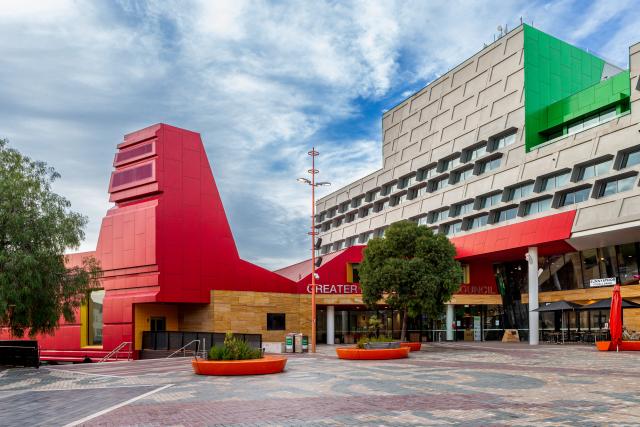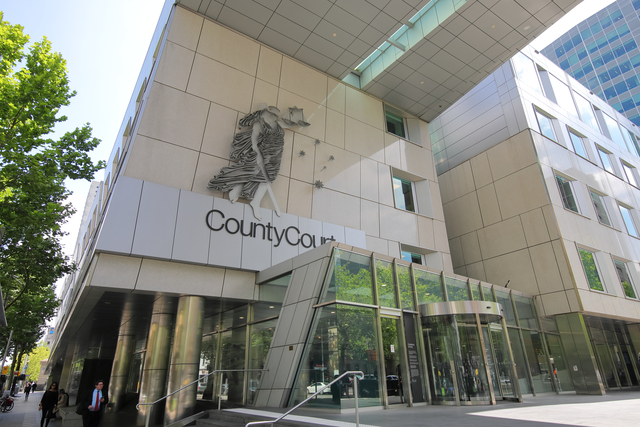Dog squad handlers and their four-legged crime-fighting partners both love the thrill of the chase, SANDRA BULL reports.
A POLICE dog’s bark is worse than its bite. Mostly. Dog squad trainer Senior
Constable Gary Murray says it’s a misconception that police want angry, aggressive hounds straining on the leash.
“People think we want dogs to be aggressive and ready to bite. But we want our dogs to have a good temperament and nature and be able to interact with the community.”
But as experienced criminals know, when a police dog is sniffing around it’s better to come out of hiding than run away.
“Biting is not common, but it happens. It has to be justified, just as when a police member uses a baton or [capsicum] spray. Dogs will only bite if someone is struggling or fleeing or assaulting the dog or its handler,” Senior Constable Murray says at the squad’s Attwood base in Melbourne’s west.
There is a strong sense of history at the base. Office walls are plastered with photographs of past and present handlers and their dogs, some dating back to the mid-1970s when the squad began.
Members of the tightly knit team also have their own catchphrases. Offenders are often referred to as “crooks”, play items used to reward dogs are “articles” and successful apprehensions are “catches”.
A dog’s reward for a catch is never food – they are delighted with a bit of playtime with a ball or old shoe and the sheer satisfaction of catching their ‘prey’.
The squad also has outposts at police stations in Springvale, Glen Waverley, Footscray and Northcote. Its 45 members, and their canine partners, can be sent anywhere in Victoria, whether it’s to catch a “crook”, track down a missing child or lost senior citizen or help control an unruly crowd.
The squad was responsible for more than 1500 arrests in 2011 and is on target to achieve similar results this year.
Leading Senior Constable Ryan Porter, 36, and his German shepherd Vice, are based at Springvale, which means they are more likely to be called on for jobs in the region spanning from St Kilda to Dandenong, Pakenham, Frankston and the Mornington Peninsula.
Vice is Leading Senior Constable Porter’s second dog in his four years in the dog squad. He is typical of handlers who, like their canine companions, would rather be jumping fences than ploughing through paperwork.
“I originally thought I wanted to become a detective, but once I did that I found it meant a lot of time behind the desk; that didn’t suit my nature. The police force gives you the opportunity for lots of different roles,” he says. “The dog squad isn’t everyone’s cup of tea, but for me it’s a perfect fit. I love it.”
The bond between handlers and their dogs becomes evident when he reminisces about his first police dog, Zol, who was at his side for about three years before being euthanised in December after an immune disease attacked his spine. “It was very sad. He had a really good tracking ability. It was a terrible Christmas.”
The bond is unsurprising as the dogs are never far from their handlers. They live at the family home in a purpose-built kennel and travel in ‘doggy div vans’, where they are safely restrained in the back. If a dog is retired or injured, handlers have to go through an intensive training process with their replacement to ensure they are a good match and learn to pick up each other’s cues.
“Zol was a very big, strong placid dog, a bit like a big bear, and I like to think he tried to please me by doing what I asked. He was quite happy to do his job and quite happy to relax when we were at home,” Leading Senior Constable Porter says.
“Vice is like a 16-year-old boy – he’s certainly a lot younger, very active and on a higher gear.”
The pair are working well together, with Vice recently giving him an early “heads up” to a man wielding a metal pole. “He wouldn’t put the pole down and kept coming at me pretty aggressively so I let Vice go and he bit him. The man dropped the pole but kept punching and hitting at Vice.
“But generally, while people may not have any issues in trying to fight police members, the presence of a dog is usually enough to de-escalate situations.”
Handlers and their dogs need this seamless communication, especially as they often search at night and need to dodge obstacles ranging from garden stakes to tree branches.
“Every dog is different with their body language. When Vice is tracking and knows he is getting close to whatever we’re searching for, the tail comes up and he is very focused. It’s a real team effort. The dogs have abilities well beyond our own, but they can only do so much. They’re telling me one thing and I have to interpret it.”
Officer in charge of the dog squad, Senior Sergeant Shaun McGovern, says one of the strongest attributes of a police dog is its ability to track human scent.
“A great example was in Hoppers Crossing in June where an offender, wanted in relation to dumping a stolen car around 2am, was tracked by police dog Kaos some 20 minutes later,” Senior Sergeant McGovern said.
“The track, approximately three kilometres long, led the handler along bike tracks, railway lines and across both lanes of the Princes Freeway. It continued through fences, across paddocks, through factory yards to where the offender was finally located.”
Playful German shepherd pups at Attwood are months away from being fully fledged general duties police dogs – if they make the cut.
Tumbling over each other and mouthing at toys, a trio of pups stick their heads a little under a wire fence and start pulling out grass as Senior Constable Murray looks on approvingly.
These are the full-on, high-energy hounds that have the best chance of making the grade. Timid couch potatoes are soon weeded out as potential crime fighters.
“We want the X factor … the drive to want to work. It’s like some people are naturally lazy or workaholics. We want the dogs to be happy to work and train hard.”
The furry raw recruits are already in training, although they don’t know it. A tape in the background blares out a cacophony of sounds: fireworks, gunshots, thunder, a screaming baby, all things which could disconcert a dog if it hears them for the first time out on a job.
Plastic bags attached to fences serve the same purpose of desensitising the dogs to unexpected sights and sounds, with Senior Constable Murray keen to add a garden gnome to the array. Field trips to hear the police helicopter and see the mounted branch in action are also part of the training. Senior Constable Murray says while squad members have an affinity for dogs, die-hard ‘dog lovers’ aren’t wanted.
“With us, dogs are not a commodity but they are a tool and we have to utilise them in the best possible way for Victoria Police. A dog is a tool of my trade. It sounds harsh but you make sure you have an end product that you can use and they’re a very clever tool.”
Leading Senior Constable Ryan Porter will keep Vice at home when the dog retires at the end of his working life, a gesture of respect that most handlers make.
A strong, alert animal, with an impressive bark, Vice is devoted to his handler and there’s plenty of playful licks on the face when the pair pose for the Weekly. But as with all police dogs, anyone apart from the handler who feels tempted to give them a friendly pat risks being bitten.
While not going so far as attributing dogs with the capacity to love their handlers, Leading Senior Constable Porter says an undeniable bond exists. “I think that bond really does contribute to dogs and their handlers being persistent. There’s only so much a dog is going to do for a tennis ball or a football. To keep driving and going, there’s got to be something more.
“And I would say handlers are very alike. We’re a tightly knit little group and a lot of that would come from sharing the same qualities.”







